
This 30 inch two-draw telescope started life around 1850, made by Spencer Browning & Co, at either 111 Minories, or 6 Vine Street, in London. For this date, this was an advanced unit, as it was designed under their Patent for ‘Pancratic’ operation, ie providing varying degrees of magnifying power.
This feature also led to very lengthy engraving of complex operating instructions on the two brass draws: Basically relative movement of the two draws lengthens the distance between the two sets of lens cartridges at either end, and moving both draws together backwards and forwards from the objective lens at the front of the telescope, adjusts the focus. The instructions are engraved mainly in a Gothic type of script, which is difficult to reproduce on this web-page:
On the Second, inner Draw:
Spencer Browning & Co
London
PATENT PANCRATIC
This tube alone to be used for the
purpose of adjusting the
focus to suit the eye

On the First, outer Draw:
High Power
To be drawn out to the double
line and the focus
adjusted by sliding in
the other drawer only
to be used in the daytime
when the weather is clear
The objective itself is very thick, approximately 16mm, which might imply a triple lens combination. It has a diameter of 40mm. Overall operating max length is 77cm, and with the two draws collapsed it would go down to a length of 47cm. The tapered main barrel is brass, currently with no covering.
The owners of the Eagle, a Welsh sloop
 It is postulated that this telescope could have been bought from Spencer Browning & Co in the 1850s by a member of the Richards family, which would have been either John Richards the Elder of Borth (seven miles North of Aberystwyth) in Wales, or Evan Richards of Aberystwyth. In January 1845 John Richards the Elder had bought the locally owned ship known as the “Eagle”. This had been built 26 years before that, in 1819, at New Quay in Cardiganshire, now known as Ceredigion: it was a 31 ton sloop, fore and aft rigged with a running bowsprit, with a square stern, and carvel built, apparently with one mast, and one deck. Stem to stern was 38.4 feet, breadth 12.4ft, Depth at mid-ships in the hold 6.7ft. The history of New Quay website advises that 31 ships were built at New Quay during the period 1800-1820, most of which were Sloops- it was the standard vessel built in West Wales for the coastal trade. Similar vessel designs below 30 tons were known as ‘Smacks’.
It is postulated that this telescope could have been bought from Spencer Browning & Co in the 1850s by a member of the Richards family, which would have been either John Richards the Elder of Borth (seven miles North of Aberystwyth) in Wales, or Evan Richards of Aberystwyth. In January 1845 John Richards the Elder had bought the locally owned ship known as the “Eagle”. This had been built 26 years before that, in 1819, at New Quay in Cardiganshire, now known as Ceredigion: it was a 31 ton sloop, fore and aft rigged with a running bowsprit, with a square stern, and carvel built, apparently with one mast, and one deck. Stem to stern was 38.4 feet, breadth 12.4ft, Depth at mid-ships in the hold 6.7ft. The history of New Quay website advises that 31 ships were built at New Quay during the period 1800-1820, most of which were Sloops- it was the standard vessel built in West Wales for the coastal trade. Similar vessel designs below 30 tons were known as ‘Smacks’.
The average economic life of a Sloop in the coastal trade was 30 years. The Eagle was owned by a consortium of shareholders when new, in 1819, and it is likely that it traded from a base at Llangrannog, 7 miles South of new Quay. They then sold the ship to David and Evan Jones, mariners of Aberystwyth, on 17 January 1838. It was therefore getting old when they sold it on to John Richards in 1845: Richards used a loan from the merchant, Thomas Jones of Aberystwyth, to complete the purchase. Thomas Jones was an importer of Canadian timber, and supplied many of the local shipbuilders with the wood to build their sloops, so was deeply involved in the shipping industry. John subsequently passed ownership of the Eagle to Evan Richards of Aberystwyth, presumably a member of his family.

Sloops discharging cargo at Aberporth
Evan Richards, we believe, sailed the ship as a coaster in the Irish Sea, around the west coast from Bristol and up to Liverpool. Normal crew for such vessels would be two men and a boy: but it appears that Evan Richards sailed with his wife and child only. It was relatively normal for the Master’s wives to sail with them as crew. Cargoes varied, from general goods, crockery etc and building materials like tiles, brought into West Wales from Bristol, to lime for farmers, and anthracite dust (culm), which was mixed with clay on delivery to Wales, and used as a slow burning fuel. Exports were not high, but would include local farm produce: also manure was shipped to Ireland, and a trade developed in delivering Welsh stone and mined slate to England and Ireland. Most of the loading and unloading took place from the beaches, the sloops had relatively flat bottoms, so were able to beach themselves at high tide and then stay more-or-less upright when the tide went out.
The wreck of the Eagle
In October 1859 Evan Richards was probably sailing to Liverpool, with his wife and child on board, his wife acting as the other crew member. On the night of 25-26 October, a major storm hit the Irish Sea, later to be known as The Royal Charter storm. Around 133 ships were wrecked, and a further 90 badly damaged – around 800 people lost their lives.
One of these wrecks was the Eagle, which foundered off the coast of Abergele in North Wales, in Llandudno Bay. From a report later sent to the local papers by Mr Richards (reproduced below), his wife and child were drowned. The newspaper report thanked the people of Abergele and Rhyl for the many kindnesses Mr Richards had received that night, and in the days after the wreck. The Eagle, its contents and any cargo, was totally lost, and the ship broke up.
The telescope is found
Some 130 years later, this telescope was reported to have been found on the beach at Pensarn, about half a mile from Abergele. It was passed to an antique shop owner in Rhyl, who made the link to ‘The Eagle’, and offered it for sale in his shop in the 1990s. For over 20 years it was left ‘as found’, until a clear-out meant it went up for sale on Ebay in 2016.

Once I received it I did clean the lenses, to see what would be the result. The dirt and deposits meant that there was previously no light transmitted. The objective lens, on the outer face, has suffered a lot of chip damage to the edges, which would be consistent with a battering by small stones in the sea. All the joints were tight, so it is possible there was some air trapped between the various lenses, which might have improved its buoyancy, during maybe 130 years under water.

The brass is now dark brown to black, except where the draws were intimately covered with another brass tube or slider, where they remained bright brass, even polished! This telescope is unusual in having the two draws in intimate contact, one inside the other as a tight fit: there is nothing to stop the inner draw pulling out fully, and this is this one which remained bright and polished where it was still inserted. Note the thread on the eyepiece end of the middle draw: there is on item found to fit on this thread, it was maybe a finger-hold/pull ring to ease the relative movement of the two tubes.

The dirt collected on the internal lens of the eyepiece cartridge
OK, so the view was poor, but the telescope was still useable. It did not take long to identify the problem, one lens was missing from the second cartridge in the middle of the scope. There was no glass debris, so maybe the scope was damaged before the shipwreck? Obviously when it was found, it was in an extended state, so it would have been ready for use before it went into the sea, it was not totally discarded as un-useable.

The ‘missing’ lens from the middle cartridge
The whole cartridge has currently been replaced with a similar one from a George Stebbing (of Portsmouth) scope that pre-dates Browning Spencer & Co. Now the telescope works very well, despite the objective lens edge chips. Also the Pancratic feature works really well, making a very high magnification possible.
What’s next?
The telescope, in its current state, and this story, with Mr Richard’s letter to the local Abergele paper, the Carnarvon and Denbigh Herald, following the shipwreck (as reproduced below), should really be in a Museum, maybe alongside a properly polished version of a similar model – which will be quite hard to find!
But how much of the above account is wishful thinking? What do you think?
Mr Richards’ Letter
Taken from the website http://www.peoplescollection.wales/items/45143:
It is likely that it was Mr Evan Richards who wrote the following letter to the newspaper:
‘Dear Sir, my vessel, THE EAGLE of Aberystwyth having been totally wrecked during the late gales off Llandrillo, and my poor wife and child drowned on the sad occasion, I shall feel extremely obliged if you will allow me through the medium of your paper to communicate my most sincere and heartfelt gratitude to those humane and hospitable people of Abergele and Rhyl, on whose hospitable shore I was cast, for the benevolent and hospitable conduct they manifested, and the assistance they so readily afforded to me in the mournful and distressing condition I was placed in. I was received in the middle of that stormy (and to me and thousands of others sadly memorable night), by Mr Hugh Jones, gardener of Bryndunoedd, from who I received every attention and assistance that my case required and to whom and his kind employer my gratitude is especially due. And those who took such deep interest in my behalf and enabled me to bury my wife and child, and supplied me with food, clothing and the means of returning home, I am especially grateful to Lady Hesketh, Gwrych Castle, the Rev Mr Hughes, Llandrillo, Fosketh esquire, Mr Richards, wine merchant, Abergele, Mr Owen of the Harp, Mr Hughes of the Ship, both of the same place, Captain Edward Roberts , West Parade , Rhyl, and Messers Robert and Rees Rees of the same place, jewellers. These kind and benevolent persons used their utmost influence to solicit subscriptions for me, rendered me every comfort and assistance in their power, and I may add their kind sympathy, and to each of them individually, and all others who assisted me, I return my heartfelt thanks assuring them that their timely aid, and kind sympathy will never be erased from the memory of.
Yours, very true servant Richards, late of the Eagle’.
Sources quoted by The People’s Collection Wales include:
Carnarvon and Denbigh Herald, 19 November 1859, Pg3 Col 1
Campbell-Jones, S, 1974, Shipbuilding at New Quay 1779-1878, Journal of the Ceredigion Antiquarian Society, pg299
Port of Aberystwyth Shipping Register 1832 – 1840, Ceredigion Archive Service AT/SHIP 2, folio 140
Port of Aberystwyth Shipping Register 1840-1853, Ceredigion Archive Service AT/SHIP 3, folios 76 and 279.
Other facts about the Eagle, and the picture at Aberporth, were taken from the book “The Ships and Seamen of Southern Ceredigion” by J Geraint Jenkins, 1982.


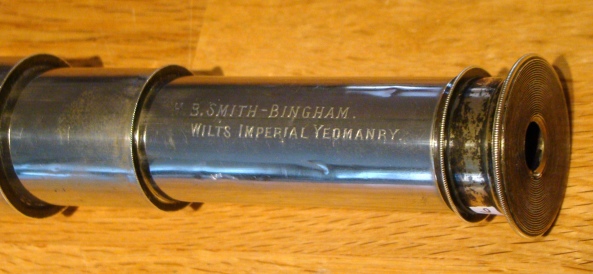


 This telescope has all the features that you would seek for in a vintage instrument. Apart from that it is a classic design of three draw, mahogany barrel telescope, medium sized at 23” long extended, and complete with leather case – and it works well.
This telescope has all the features that you would seek for in a vintage instrument. Apart from that it is a classic design of three draw, mahogany barrel telescope, medium sized at 23” long extended, and complete with leather case – and it works well.






 It is very large: indeed it seems to be a little on the ostentatious side. The eyepiece has the Victorian bell shape, and is gilded on top of the brass, as is the sunshade and the objective lens cap, on the far end of the scope. Then surprisingly the cartridge housing, located in the central split of the single draw, is also gilded, as is the one at the eyepiece. The eyepiece has had a knock, and the slider that protected the lens is now missing.
It is very large: indeed it seems to be a little on the ostentatious side. The eyepiece has the Victorian bell shape, and is gilded on top of the brass, as is the sunshade and the objective lens cap, on the far end of the scope. Then surprisingly the cartridge housing, located in the central split of the single draw, is also gilded, as is the one at the eyepiece. The eyepiece has had a knock, and the slider that protected the lens is now missing.




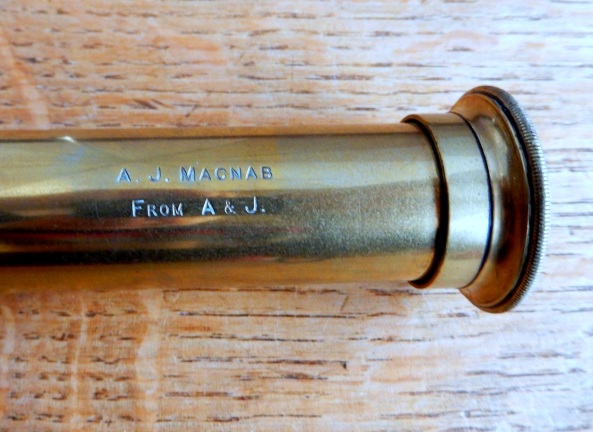
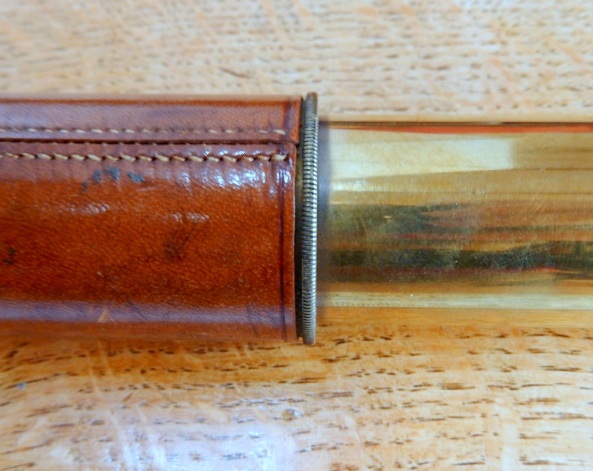




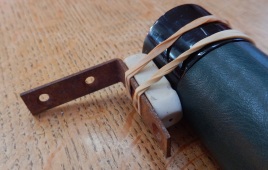 The pictures show the nearest I can reproduce to the original location system these days: I lost the Meccano set when my parents moved house and I was at University – by the way, if you live at 53 Cookridge Lane, you’ll find it by crawling under the floor of the lounge!
The pictures show the nearest I can reproduce to the original location system these days: I lost the Meccano set when my parents moved house and I was at University – by the way, if you live at 53 Cookridge Lane, you’ll find it by crawling under the floor of the lounge!
 “Dollond 4-inch Brass Refracting Telescope, London, c. 1825, Bywater & Co., 58-in. main tube, ocular collar engraved “Dollond London/Sold thru Bywater & Co. Liverpool,” mounting collar, and dual tapered column mount.
“Dollond 4-inch Brass Refracting Telescope, London, c. 1825, Bywater & Co., 58-in. main tube, ocular collar engraved “Dollond London/Sold thru Bywater & Co. Liverpool,” mounting collar, and dual tapered column mount.
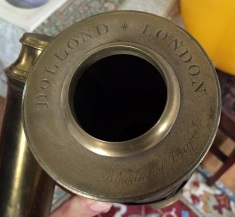




 One of Ted Corner’s later, regular ships was the Carrier Dove. It seems this was a relatively famous medium Clipper, 1694 tons, launched from Baltimore in 1855: on her maiden voyage to San Fransisco under Captain Corner, Carrier Dove was dis-masted in a hurricane just eight days out from New York. Nevertheless, she made it to Rio de Janeiro in Brazil by November 9, in 55 days, and then remained in Rio for two months for repairs. In 1856 Captain Corner was in Australia: presumably travelling from there to Peru, in 1857 he sailed the Carrier Dove from the Chincha Islands, off Peru, to Liverpool, with 1094 tons of guano: it was delivered to Anthony Gibbs & Sons.
One of Ted Corner’s later, regular ships was the Carrier Dove. It seems this was a relatively famous medium Clipper, 1694 tons, launched from Baltimore in 1855: on her maiden voyage to San Fransisco under Captain Corner, Carrier Dove was dis-masted in a hurricane just eight days out from New York. Nevertheless, she made it to Rio de Janeiro in Brazil by November 9, in 55 days, and then remained in Rio for two months for repairs. In 1856 Captain Corner was in Australia: presumably travelling from there to Peru, in 1857 he sailed the Carrier Dove from the Chincha Islands, off Peru, to Liverpool, with 1094 tons of guano: it was delivered to Anthony Gibbs & Sons.

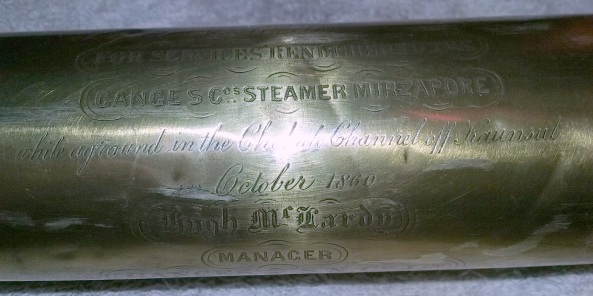
 It has been possible to determine that “IGSN” is the India General Steam Navigation Company (established 1844), and similarly “Ganges SN Co” is probably the Ganges Steam Navigation Company. References also show that there were many steam boats travelling up the Ganges, typically from Calcutta (now Kolkata) to Benares (now known as Varanasi, 600km NW of Calcutta in Northern India): these boats would need to stop to load more coal maybe three times during this journey. In 1849 there were 15 privately owned steamers travelling this route, three of which were 1000 ton P&O liners. The Indian Government, who supplied the coal to the intermediate coaling points, itself used ten riverboats. In fact one of the coaling stops was at a location/town called ‘Mirzapur’, close to Benares.
It has been possible to determine that “IGSN” is the India General Steam Navigation Company (established 1844), and similarly “Ganges SN Co” is probably the Ganges Steam Navigation Company. References also show that there were many steam boats travelling up the Ganges, typically from Calcutta (now Kolkata) to Benares (now known as Varanasi, 600km NW of Calcutta in Northern India): these boats would need to stop to load more coal maybe three times during this journey. In 1849 there were 15 privately owned steamers travelling this route, three of which were 1000 ton P&O liners. The Indian Government, who supplied the coal to the intermediate coaling points, itself used ten riverboats. In fact one of the coaling stops was at a location/town called ‘Mirzapur’, close to Benares.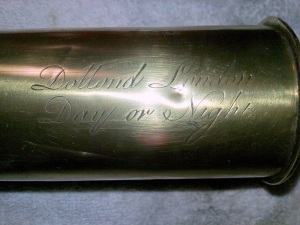 The only reference found relating to ‘Chokah’, was for the town of Choka, near Patna, on this route up the Ganges (238 miles from Calcutta), where the channel was said only to be passable by steam boats from July to October. So this could have been where the Mirzapore steamer came to grief: it is significant that the date on the telescope is for October that year!
The only reference found relating to ‘Chokah’, was for the town of Choka, near Patna, on this route up the Ganges (238 miles from Calcutta), where the channel was said only to be passable by steam boats from July to October. So this could have been where the Mirzapore steamer came to grief: it is significant that the date on the telescope is for October that year!



 Regrettably Rodney was at sea only up to the 1780s, which is right at the start of the boom in telescope production, which started following the Dollond patent of 1760, a development that made them far more efficient. So any telescope he might have used would these days be very expensive, where they have survived, and they would probably out of my price range! Incidentally, none of the later portraits of Lord Rodney show him with a telescope, which is unusual, for paintings of Admirals in those days. But surprisingly, I’ve found a portrait of him as a young man, with a telescope that looks like a 1730/40 model – very expensive now!
Regrettably Rodney was at sea only up to the 1780s, which is right at the start of the boom in telescope production, which started following the Dollond patent of 1760, a development that made them far more efficient. So any telescope he might have used would these days be very expensive, where they have survived, and they would probably out of my price range! Incidentally, none of the later portraits of Lord Rodney show him with a telescope, which is unusual, for paintings of Admirals in those days. But surprisingly, I’ve found a portrait of him as a young man, with a telescope that looks like a 1730/40 model – very expensive now!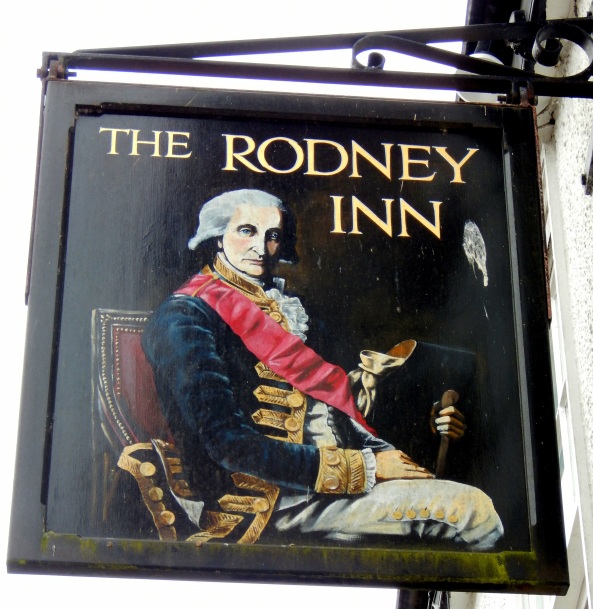

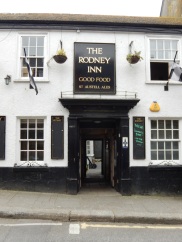




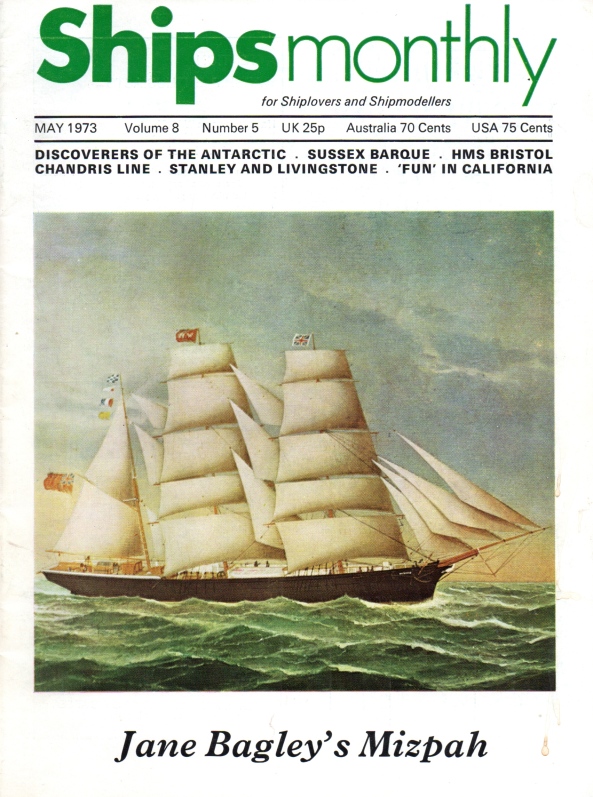
 The telescope is indeed in good condition, and complete with the lens slides etc. Capt Bagley did not go as far as having his name engraved on the telescope, nor the name of the Mizpah, so it just features the maker’s names, Blachford & Imray [Plus London, Day or Night].
The telescope is indeed in good condition, and complete with the lens slides etc. Capt Bagley did not go as far as having his name engraved on the telescope, nor the name of the Mizpah, so it just features the maker’s names, Blachford & Imray [Plus London, Day or Night].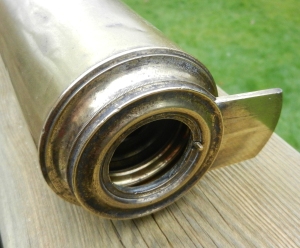 The complete thing weighs 1.25Kg, no lightweight to hold up for a while in a rough sea. OK, so you can balance it on the rigging. The largest diameter, on the barrel and sunshade, is 62mm. Dark brown leather covers the main wooden barrel structure underneath. This is used to support the main lens, the objective, which has a visible operating diameter of 39mm. But if the telescope is used with the end slider in place, and the slide is slid away to allow a view through the lens, the aperture available to accept light in the into the telescope through the slide assembly is only 28mm. So somewhere the aperture available for the optics in a 62 diameter telescope body has been restricted, so that we actually accept the light only coming into an aperture of 28mm, 45% of the telescope OD.
The complete thing weighs 1.25Kg, no lightweight to hold up for a while in a rough sea. OK, so you can balance it on the rigging. The largest diameter, on the barrel and sunshade, is 62mm. Dark brown leather covers the main wooden barrel structure underneath. This is used to support the main lens, the objective, which has a visible operating diameter of 39mm. But if the telescope is used with the end slider in place, and the slide is slid away to allow a view through the lens, the aperture available to accept light in the into the telescope through the slide assembly is only 28mm. So somewhere the aperture available for the optics in a 62 diameter telescope body has been restricted, so that we actually accept the light only coming into an aperture of 28mm, 45% of the telescope OD.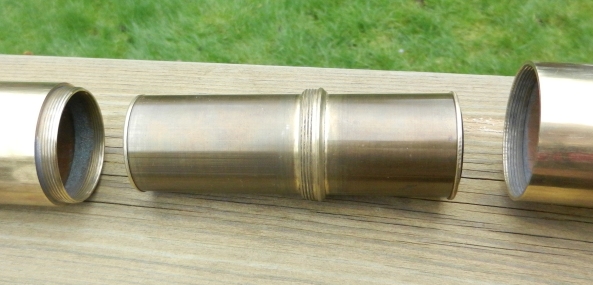
 Ships Monthly journal, May 1973.
Ships Monthly journal, May 1973.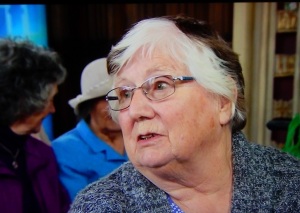 The lady with the nautical antiques was called Betty, and she brought in two sawfish (Carpenter shark) ‘rostrums’, plus the telescope, for sale. The expert, Will Axon, who apparently prefers English furniture, dismissed the telescope as a ‘working model’, and said collectors would not be interested. He obviously does not know anything about antique scientific instruments. Valuation was at first lumped together with the two rostrums (rostra?) at £150 max, but this was later split into two lots, with the scope valued £50-80.
The lady with the nautical antiques was called Betty, and she brought in two sawfish (Carpenter shark) ‘rostrums’, plus the telescope, for sale. The expert, Will Axon, who apparently prefers English furniture, dismissed the telescope as a ‘working model’, and said collectors would not be interested. He obviously does not know anything about antique scientific instruments. Valuation was at first lumped together with the two rostrums (rostra?) at £150 max, but this was later split into two lots, with the scope valued £50-80.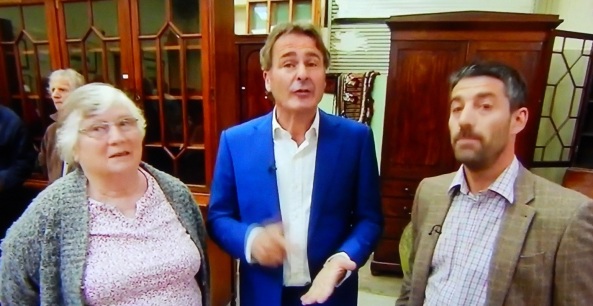






 It is postulated that this telescope could have been bought from Spencer Browning & Co in the 1850s by a member of the Richards family, which would have been either John Richards the Elder of Borth (seven miles North of Aberystwyth) in Wales, or Evan Richards of Aberystwyth. In January 1845 John Richards the Elder had bought the locally owned ship known as the “Eagle”. This had been built 26 years before that, in 1819, at New Quay in Cardiganshire, now known as Ceredigion: it was a 31 ton sloop, fore and aft rigged with a running bowsprit, with a square stern, and carvel built, apparently with one mast, and one deck. Stem to stern was 38.4 feet, breadth 12.4ft, Depth at mid-ships in the hold 6.7ft. The history of New Quay website advises that 31 ships were built at New Quay during the period 1800-1820, most of which were Sloops- it was the standard vessel built in West Wales for the coastal trade. Similar vessel designs below 30 tons were known as ‘Smacks’.
It is postulated that this telescope could have been bought from Spencer Browning & Co in the 1850s by a member of the Richards family, which would have been either John Richards the Elder of Borth (seven miles North of Aberystwyth) in Wales, or Evan Richards of Aberystwyth. In January 1845 John Richards the Elder had bought the locally owned ship known as the “Eagle”. This had been built 26 years before that, in 1819, at New Quay in Cardiganshire, now known as Ceredigion: it was a 31 ton sloop, fore and aft rigged with a running bowsprit, with a square stern, and carvel built, apparently with one mast, and one deck. Stem to stern was 38.4 feet, breadth 12.4ft, Depth at mid-ships in the hold 6.7ft. The history of New Quay website advises that 31 ships were built at New Quay during the period 1800-1820, most of which were Sloops- it was the standard vessel built in West Wales for the coastal trade. Similar vessel designs below 30 tons were known as ‘Smacks’.




